HP PhotoSmart C4585 User Manual [fr]
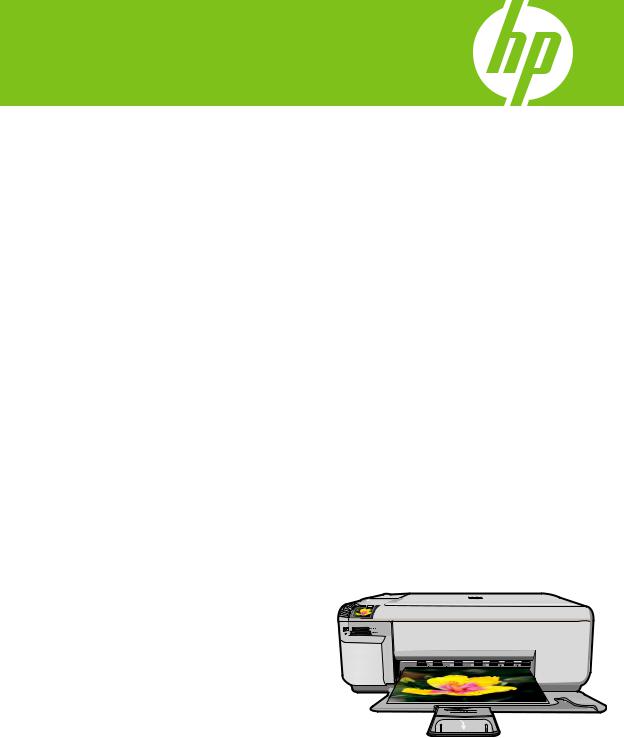
HP Photosmart C4500 All-in-One series
Basics Guide Guide d’utilisation
Guia de conceitos básicos

Hewlett-Packard Company notices
The information contained in this document is subject to change without notice.
All rights reserved. Reproduction, adaptation, or translation of this material is prohibited without prior written permission of Hewlett-Packard, except as allowed under copyright laws. The only warranties for HP products and services are set forth in the express warranty statements accompanying such products and services. Nothing herein should be construed as constituting an additional warranty. HP shall not be liable for technical or editorial errors or omissions contained herein.
© 2007 Hewlett-Packard Development Company, L.P.
Windows, Windows 2000, and Windows XP are U.S. registered trademarks of Microsoft Corporation.
Windows Vista is either a registered trademark or trademark of Microsoft Corporation in the United States and/or other countries.
Intel and Pentium are trademarks or registered trademarks of Intel Corporation or its subsidiaries in the United States and other countries.
Avis publiés par la société Hewlett-Packard
Les informations contenues dans ce document peuvent faire l'objet de modifications sans préavis.
Tous droits réservés. La reproduction, l'adaptation ou la traduction de ce matériel est interdite sans l'accord écrit préalable de Hewlett-Packard, sauf dans les cas permis par la législation relative aux droits d'auteur. Les seules garanties relatives aux produits et services HP sont décrites dans les déclarations de garantie expresse accompagnant lesdits produits et services. Aucun élément de ce document ne constitue une garantie supplémentaire. Hewlett-Packard ne saurait être tenu pour responsable des erreurs ou omissions techniques ou rédactionnelles de ce document.
© 2007 Hewlett-Packard Development Company, L.P.
Windows, Windows 2000 et Windows XP sont des marques déposées de Microsoft Corporation aux Etats-Unis.
Windows Vista est une marque déposée ou une marque de Microsoft Corporation aux Etats-Unis et/ou dans d'autres pays.
Intel et Pentium sont des marques ou des marques déposées d'Intel Corporation ou de ses filiales aux Etats-Unis et dans d'autres pays.
Avisos da Hewlett-Packard Company
As informações contidas neste documento estão sujeitas a alterações sem aviso prévio.
Todos os direitos reservados. É proibida a reprodução, adaptação ou tradução deste material sem a permissão prévia por escrito da Hewlett-Packard, exceto quando permitido pelas leis de direitos autorais. As únicas garantias aos produtos e serviços da HP são aquelas descritas nas declarações de garantia expressa que acompanham os respectivos produtos e serviços. Nada aqui contido deve ser interpretado como garantia adicional. A HP não se responsabiliza por erros técnicos ou editoriais nem por omissões aqui contidos.
© 2007 Hewlett-Packard Development Company, L.P.
Windows, Windows 2000 e Windows XP são marcas registradas da Microsoft Corporation nos Estados Unidos e/ou em outros países. Windows Vista é uma marca comercial ou marca registrada da Microsoft Corporation nos Estados Unidos e/ou em outros países.
Intel e Pentium são marcas comerciais ou marcas registradas da Intel Corporation ou suas subsidiárias nos Estados Unidos e/ou em outros países.

HP Photosmart C4500
All-in-One series
Basics Guide
English

English

Contents
1 |
Network setup |
|
|
Set up the HP All-in-One on an integrated wireless (WLAN 802.11) network |
............................2 |
|
Wireless ad hoc network setup................................................................................................... |
4 |
|
Connect to additional computers on a network.......................................................................... |
7 |
|
Change the HP All-in-One from a USB connection to a network connection............................. |
7 |
|
Configure your firewall to work with HP products....................................................................... |
8 |
|
Advanced firewall information..................................................................................................... |
9 |
|
Manage your network settings.................................................................................................... |
9 |
2 HP All-in-One overview |
|
|
|
The HP All-in-One at a glance.................................................................................................. |
11 |
|
Control panel features.............................................................................................................. |
12 |
|
Find more information............................................................................................................... |
13 |
|
Load paper............................................................................................................................... |
14 |
|
Avoid paper jams...................................................................................................................... |
15 |
|
Print a photo on photo paper.................................................................................................... |
16 |
|
Scan an image.......................................................................................................................... |
16 |
|
Replace the print cartridges...................................................................................................... |
17 |
3 |
Troubleshooting and support |
|
|
Uninstall and reinstall the software........................................................................................... |
20 |
|
Setup troubleshooting............................................................................................................... |
21 |
|
Network troubleshooting........................................................................................................... |
23 |
|
Clear paper jams...................................................................................................................... |
26 |
|
Print cartridge troubleshooting.................................................................................................. |
26 |
|
Support process....................................................................................................................... |
26 |
4 |
Technical information |
|
|
System requirements................................................................................................................ |
27 |
|
Product specifications............................................................................................................... |
27 |
|
Regulatory notices.................................................................................................................... |
27 |
|
Warranty................................................................................................................................... |
28 |
English
1

English
1 Network setup
This section describes how to connect the HP All-in-One to a network and how to view and manage network settings.
If you want to: |
See this section: |
|
|
Connect to a wireless network with a wireless |
“Set up the HP All-in-One on an integrated |
router (infrastructure). |
wireless (WLAN 802.11) network” |
|
on page 2 |
|
|
Connect directly to a wireless-capable |
“Connect to a wireless ad hoc network” |
computer without a wireless router (ad-hoc). |
on page 6 |
|
|
Add connections to more computers on the |
“Connect to additional computers on a |
network. |
network” on page 7 |
|
|
Change the HP All-in-One from a USB |
“Change the HP All-in-One from a USB |
connection to a network connection. |
connection to a network connection” |
NOTE: Use the instructions in this section if |
on page 7 |
|
|
you first installed the HP All-in-One with a USB |
|
connection, and you now want to change to a |
|
wireless network connection. |
|
|
|
View or change the network settings. |
“Manage your network settings” on page 9 |
|
|
Find troubleshooting information. |
“Network troubleshooting” on page 23 |
|
|
Set up the HP All-in-One on an integrated wireless (WLAN 802.11) network
The HP All-in-One uses an internal networking component that supports a wireless network.
For optimal performance and security in your wireless network, HP recommends you use a wireless router or access point (802.11) to connect the product and the other network elements. When network elements are connected through a wireless router or access point, this is called an infrastructure network.
2 HP Photosmart C4500 All-in-One series

The advantages of a wireless infrastructure network as compared to an ad hoc network include:
•Advanced network security
•Enhanced reliability
•Network flexibility
•Better performance
•Shared Broadband Internet access
To set up the HP All-in-One on an integrated |
See this section: |
wireless WLAN 802.11 network, you need to |
|
do the following: |
|
First, collect all of the required materials. |
“What you need for an integrated wireless |
|
WLAN 802.11 network” on page 3 |
|
|
Next, install the software and connect the |
“Connect to an integrated wireless WLAN |
HP All-in-One to the wireless router. |
802.11 network” on page 3 |
|
|
What you need for an integrated wireless WLAN 802.11 network
To connect the HP All-in-One to an integrated wireless WLAN 802.11 network, you will need the following:
A wireless 802.11 network that includes a wireless router or access point.
A desktop computer or laptop with either wireless networking support, or a network interface card (NIC). The computer must be connected to the wireless network that you intend to install the HP All-in-One on.
Broadband Internet access (recommended) such as cable or DSL.
If you connect the HP All-in-One on a wireless network that has Internet access, HP recommends that you use a wireless router (access point or base station) that uses Dynamic Host Configuration Protocol (DHCP).
Network name (SSID).
WEP key or WPA Passphrase (if needed).
A USB setup cable to connect temporarily for transferring wireless settings.
Connect to an integrated wireless WLAN 802.11 network
The HP Photosmart Software CD and included USB setup cable provide an easy way to connect the HP All-in-One to your wireless network.
 CAUTION: To prevent other users from accessing your wireless network, HP strongly recommends using a password or passphrase (WPA or WEP security) and a unique network name (SSID) for your wireless router. Your wireless router might have been shipped with a default network name, which is typically the manufacturer name. If you use the default network name, your network can be easily accessed by other users using the same default network name (SSID). It also means that the HP All-in-One might accidently connect to a different wireless network in your area which uses the same network name. If this happens you will not be able to access the HP All-in-One. For more information on how to change the network name, see the documentation that came with your wireless router.
CAUTION: To prevent other users from accessing your wireless network, HP strongly recommends using a password or passphrase (WPA or WEP security) and a unique network name (SSID) for your wireless router. Your wireless router might have been shipped with a default network name, which is typically the manufacturer name. If you use the default network name, your network can be easily accessed by other users using the same default network name (SSID). It also means that the HP All-in-One might accidently connect to a different wireless network in your area which uses the same network name. If this happens you will not be able to access the HP All-in-One. For more information on how to change the network name, see the documentation that came with your wireless router.
English
Set up the HP All-in-One on an integrated wireless (WLAN 802.11) network |
3 |

English
Chapter 1
To connect the product
1.Insert the product software CD in the computer CD-ROM drive.
2.Follow the instructions on the screen.
When you are prompted, connect the product to the computer using the USB setup cable included in the box. The product will attempt to connect to the network. If the connection fails, follow the prompts to correct the problem, and then try again.
3.When the setup is finished, you will be prompted to disconnect the USB cable and test the wireless network connection. Once the product connects successfully to the network, install the software on each computer that will use the product over the network.
Wireless ad hoc network setup
Use this section if you want to connect the HP All-in-One to a wireless-capable computer without using a wireless router or access point.
There are two methods you may use to connect the HP All-in-One to your computer using an ad hoc wireless network connection. Once connected, you can install the
HP All-in-One software.
▲Turn on the wireless radio for the HP All-in-One and the wireless radio on your computer. On your computer, connect to the network name (SSID) hpsetup, which is the default ad hoc network created by the HP All-in-One.
OR
▲Use an ad hoc network profile on your computer to connect to the product. If your computer is not currently configured with an ad hoc network profile, consult the Help file for your computer Operating System for the proper method to create an ad hoc profile on your computer. Once the ad hoc network profile has been created, insert the installation CD that came with the product and install the software. Connect to the ad hoc network profile you created on your computer.
 NOTE: An ad hoc connection can be used if you do not have a wireless router or access point but do have a wireless radio on your computer. However, an ad hoc connection may result in a lower level of network security and possibly reduced performance when compared to an infrastructure network connection using a wireless router or access point.
NOTE: An ad hoc connection can be used if you do not have a wireless router or access point but do have a wireless radio on your computer. However, an ad hoc connection may result in a lower level of network security and possibly reduced performance when compared to an infrastructure network connection using a wireless router or access point.
4 HP Photosmart C4500 All-in-One series

To set up the HP All-in-One on a wireless ad |
See this section: |
hoc network, you need to do the following: |
|
|
|
First, collect all of the required materials. |
“What you need for an ad hoc network” |
|
on page 5 |
|
|
Next, prepare your computer by creating a |
“Create a network profile for a Windows Vista or |
network profile. |
Windows XP computer” on page 5 |
|
“Create a network profile for other operating |
|
systems” on page 6 |
|
|
Finally, install the software and connect to the |
“Connect to a wireless ad hoc network” |
appropriate network profile. |
on page 6 |
|
|
What you need for an ad hoc network
To connect the HP All-in-One to a Windows computer with an ad hoc connection, the computer must have a wireless network adapter and an ad hoc profile. You will also need a USB setup cable to connect temporarily for transferring wireless settings.
English
Create a network profile for a Windows Vista or Windows XP computer
Prepare your computer for an ad hoc connection by creating a network profile.
To create a network profile
 NOTE: The product comes configured with a network profile with hpsetup as the network name (SSID). However, for security and privacy HP recommends you create a new network profile on your computer as described here.
NOTE: The product comes configured with a network profile with hpsetup as the network name (SSID). However, for security and privacy HP recommends you create a new network profile on your computer as described here.
1.In the Control Panel, double-click Network Connections.
2.On the Network Connections window, right-click Wireless Network Connection. If you see Enable on the pop-up menu, select it. Otherwise, if you see Disable on the menu, the wireless connection is already enabled.
3.Right-click the Wireless Network Connection icon, and then click Properties.
4.Click the Wireless Networks tab.
5.Select the Use Windows to configure my wireless network settings check box.
6.Click Add, and then do the following:
a. In Network name (SSID) box, type in a unique network name of your choice.
 NOTE: The network name is case sensitive, so it is important to remember any uppercase (capital) and lowercase (small) letters.
NOTE: The network name is case sensitive, so it is important to remember any uppercase (capital) and lowercase (small) letters.
b. If there is a Network Authentication list, select Open. Otherwise, go to the next step.
c. In the Data encryption list, select WEP.
 NOTE: It is possible to create a network that does not use a WEP key. However, HP recommends using a WEP key in order to secure your network.
NOTE: It is possible to create a network that does not use a WEP key. However, HP recommends using a WEP key in order to secure your network.
d. Make sure that the check box next to The key is provided for me automatically is not selected.
Wireless ad hoc network setup |
5 |

English
Chapter 1
e. In the Network key box, type a WEP key that has exactly 5 or exactly 13 alphanumeric (ASCII) characters. For example, if you enter 5 characters, you might enter ABCDE or 12345. Or, if you enter 13 characters, you might enter ABCDEF1234567. (12345 and ABCDE are examples only. Select a combination of your choice.)
Alternatively, you can use HEX (hexadecimal) characters for the WEP key. A HEX WEP key must be 10 characters for 40 bit encryption, or 26 characters for 128 bit encryption.
f. In the Confirm network key box, type the same WEP key you typed in the previous step.
 NOTE: You must remember the exact uppercase (capital) and lowercase (small) letters. If you enter your WEP key incorrectly on the product, the wireless connection will fail.
NOTE: You must remember the exact uppercase (capital) and lowercase (small) letters. If you enter your WEP key incorrectly on the product, the wireless connection will fail.
g. Write down the WEP key exactly as you typed it, including uppercase and lowercase letters.
h. Select the check box for This is a computer-to-computer (ad hoc) network; wireless access points are not used.
i. Click OK to close the Wireless network properties window, and then click OK again.
j. Click OK again to close the Wireless Network Properties Connection window.
Create a network profile for other operating systems
If you have an operating system other than Windows Vista or Windows XP, HP recommends that you use the configuration program that came with your wireless LAN card. To find the configuration program for your wireless LAN card, access your computer's list of programs.
Using the LAN card configuration program, create a network profile that has the following values:
•Network name (SSID): Mynetwork (example only)
 NOTE: You should create a network name that is unique and easy for you to remember. Just remember that the network name is case-sensitive. Therefore, you must remember which letters are uppercase and lowercase.
NOTE: You should create a network name that is unique and easy for you to remember. Just remember that the network name is case-sensitive. Therefore, you must remember which letters are uppercase and lowercase.
•Communication mode: Ad Hoc
•Encryption: enabled
Connect to a wireless ad hoc network
The HP Photosmart Software CD and included USB setup cable provide an easy way to connect the HP All-in-One directly to your computer for an ad-hoc wireless network.
6 HP Photosmart C4500 All-in-One series

To connect the product
1.Insert the product software CD in the computer CD-ROM drive.
2.Follow the instructions on the screen.
When you are prompted, connect the product to the computer using the USB setup cable included in the box. The product will attempt to connect to the network. If the connection fails, follow the prompts to correct the problem, and then try again.
3.When the setup is finished, you will be prompted to disconnect the USB cable and test the wireless network connection. Once the product connects successfully to the network, install the software on each computer that will use the product over the network.
Connect to additional computers on a network
You can connect the HP All-in-One to a small number of computers on a network. If the HP All-in-One is already connected to a computer on a network, for each additional computer you must install the HP All-in-One software. During installation of a wireless connection, the software will discover the product on the network. Once you have set up the HP All-in-One on the network you will not need to configure it again when you add additional computers.
To install the Windows HP All-in-One software on additional networked computers
1.Quit all applications running on your computer, including any virus detection software.
2.Insert the Windows CD that came with the HP All-in-One into the CD-ROM drive on your computer and follow the onscreen instructions.
3.If a dialog box about firewalls appears, follow the instructions. If you see firewall popup messages, you must always accept or allow the pop-up messages.
4.On the Connection Type screen, select Through the network, and then click
Next.
The Searching screen appears as the Setup program searches for the HP All-in-One on the network.
5.On the Printer Found screen, verify that the printer description is correct.
If more than one printer is found on the network, the Printers Found screen appears. Select the HP All-in-One you want to connect.
6.Follow the prompts to install the software.
When you have finished installing the software, the HP All-in-One is ready for use.
7.If you disabled any virus detection software on your computer, make sure to enable it again.
8.To test your network connection, go to your computer and print a test page to the HP All-in-One.
English
Change the HP All-in-One from a USB connection to a network connection
If you first install the HP All-in-One with a USB connection, you can later change to a wireless network connection. If you already understand how to connect to a network, you can use the general directions below.
Change the HP All-in-One from a USB connection to a network connection |
7 |

Chapter 1
English
 NOTE: For optimal performance and security in your wireless network, use an access point (such as a wireless router) to connect the HP All-in-One.
NOTE: For optimal performance and security in your wireless network, use an access point (such as a wireless router) to connect the HP All-in-One.
To change a USB connection to an integrated wireless WLAN 802.11 connection
1.Unplug the USB connection from the back of the product.
2.Insert the product CD in the computer CD-ROM drive.
3.Follow the onscreen instructions for a wireless network installation.
4.When the installation is complete, open Printers and Faxes (or Printers) in the Control Panel and delete the printers for the USB installation.
For more detailed instructions on connecting the HP All-in-One to a network, see:
•“Set up the HP All-in-One on an integrated wireless (WLAN 802.11) network” on page 2
•“Connect to a wireless ad hoc network” on page 6
Configure your firewall to work with HP products
A personal firewall, which is security software running on your computer, can block network communication between your HP product and your computer.
If you are having problems such as:
•Printer not found when installing HP software
•Unable to print, print job stuck in queue or printer goes offline
•Scan communication errors or scanner busy messages
•Unable to see printer status on your computer
The firewall might be preventing your HP product from notifying computers on your network where it can be found. If the HP software cannot find the HP product during installation (and you know the HP product is on the network), or you have already successfully installed HP software and experience problems, try the following:
1.In the firewall configuration utility, look for an option to trust computers on the local subnet (sometimes called the “scope” or “zone”). By trusting all computers on the local subnet, computers and devices in your home can communicate with each other while still being protected from the internet. This is the easiest approach to use.
2.If you do not have the option to trust computers on the local subnet, add incoming UDP port 427 to your firewall's list of allowed ports.
 NOTE: Not all firewalls require you to differentiate between incoming and outgoing ports, but some do.
NOTE: Not all firewalls require you to differentiate between incoming and outgoing ports, but some do.
Another common problem is that HP software is not trusted by your firewall to access the network. This can happen if you answered "block" to any firewall dialog boxes that appeared when you installed the HP software.
If this occurs, check that the following programs are in your firewall's list of trusted applications; add any that are missing.
•hpqkygrp.exe, located in C:\program files\HP\digital imaging\bin
•hpqscnvw.exe, located in C:\program files\HP\digital imaging\bin
•hpqste08.exe, located in C:\program files\HP\digital imaging\bin
•hpqtra08.exe, located in C:\program files\HP\digital imaging\bin
•hpqthb08.exe, located in C:\program files\HP\digital imaging\bin
8 HP Photosmart C4500 All-in-One series

 NOTE: Refer to your firewall documentation on how to configure the firewall port settings and how to add HP files to the "trusted" list.
NOTE: Refer to your firewall documentation on how to configure the firewall port settings and how to add HP files to the "trusted" list.
NOTE: Some firewalls continue to cause interference even after you disable them. If you continue to have problems after configuring the firewall as described above, you might need to uninstall the firewall software in order to use the product over the network.
Advanced firewall information
The following ports are also used by your HP product and might need to be opened on your firewall configuration. Incoming ports (UDP) are destination ports on the computer while outgoing ports (TCP) are destination ports on the HP product.
•Incoming (UDP) ports: 137, 138, 161, 427
•Outgoing (TCP) ports: 137, 139, 427, 9100, 9220, 9500
The ports are used for the following functions:
Printing |
Photo card upload |
||
• UDP ports: 427, 137, 161 |
• |
UDP ports: 137, 138, 427 |
|
• |
TCP port: 9100 |
• |
TCP port: 139 |
Scanning |
Product status |
||
• |
UDP port: 427 |
UDP port: 161 |
|
•TCP ports: 9220, 9500
Faxing |
Product installation |
• UDP port: 427 |
UDP port: 427 |
•TCP port: 9220
English
Manage your network settings
The HP All-in-One control panel enables you to perform a variety of network management tasks. This includes printing the network settings, restoring the network defaults, turning the wireless radio on and off, and printing a wireless network test.
Print network settings
You can print a network configuration page to see network settings such as the IP address, communication mode, and network name (SSID).
To print the network configuration page
1.Press the Wireless button on the product.
2.Press the button next to the down arrow on the display until Print Network Configuration Page is highlighted, and then press OK.
Restore network defaults
You can reset the network settings to what they were when you purchased the HP All-in-One.
Manage your network settings |
9 |

English
Chapter 1
To restore network defaults
1.Press the Wireless button on the product.
2.Press the button next to the down arrow on the display until Restore Network Defaults is highlighted, and then press OK.
3.Confirm that you want to restore the network defaults.
Turn the wireless radio on and off
The wireless radio is off by default, but when you install the software and connect the HP All-in-One to the network, the wireless radio is turned on automatically. The blue light on the front of the HP All-in-One indicates that the wireless radio is on. In order to stay connected to a wireless network, the radio must stay on. However, if the HP All-in-One is connected directly to a computer with a USB connection, the radio is not used. In this case you might want to turn the radio off.
To turn the wireless radio on and off
1.Press the Wireless button on the product.
2.Press the button next to the down arrow on the display until Turn Radio On or Turn Radio Off is highlighted, and then press OK.
Print the wireless network test
The wireless network test performs a series of diagnostic tests to determine whether network setup is successful. If an issue is detected, a recommendation on how to correct the issue will be included on the printed report. You can print the wireless network test at any time.
To print the wireless test report
1.Press the Wireless button on the product.
2.Press the button next to the down arrow on the display until Wireless Network Test is highlighted, and then press OK.
The Wireless Network Test prints.
10 HP Photosmart C4500 All-in-One series

2 HP All-in-One overview
Use the HP All-in-One to quickly and easily accomplish tasks such as making a copy, scanning documents, or printing photos from a memory card or USB storage device. You can access many HP All-in-One functions directly from the control panel, without turning on your computer.
 NOTE: This guide introduces basic operations and troubleshooting, as well as provides information for contacting HP support and ordering supplies.
NOTE: This guide introduces basic operations and troubleshooting, as well as provides information for contacting HP support and ordering supplies.
The onscreen Help details the full range of features and functions, including use of the HP Photosmart Software that came with the HP All-in-One.
English
The HP All-in-One at a glance
Label |
Description |
|
|
1 |
On button |
|
|
2 |
Wireless network indicator light and button |
|
|
3 |
Control panel |
|
|
4 |
Memory card slots |
|
|
5 |
Input tray |
|
|
6 |
Paper tray extender (also referred to as the tray extender) |
|
|
7 |
Paper-width guide |
|
|
8 |
Print cartridge door |
|
|
9 |
Glass |
|
|
10 |
Lid backing |
|
|
HP All-in-One overview |
11 |

English
Chapter 2
(continued)
Label Description
11Rear door
12Rear USB port
13Power connection*
*Use only with the power adapter supplied by HP.
Control panel features
The following diagram and related table provide a quick reference to the HP All-in-One control panel features.
|
|
|
|
|
|
|
|
|
|
|
|
|
|
|
|
|
|
|
|
|
|
|
|
|
|
|
|
|
|
|
|
Label |
Icon |
|
Name and Description |
||||
|
|
|
|
|
|||
1 |
|
|
|
On: Turns the product on or off. When the product is off, a |
|||
|
|
|
|
minimal amount of power is still used. To completely remove |
|||
|
|
|
|
power, turn off the product, and then unplug the power cord. |
|||
|
|
|
|
|
|||
2 |
|
|
|
Wireless: Opens the Wireless menu. By default, the wireless |
|||
|
|
|
|
feature is off. When turned on, it enables wireless printing and |
|||
|
|
|
|
scanning. |
|||
|
|
|
|
|
|||
3 |
|
|
|
Settings: Opens the Photo settings menu when a memory |
|||
|
|
|
|
card is inserted. Otherwise, this button opens the Copy |
|||
|
|
|
|
settings menu. |
|||
|
|
|
|
|
|||
4 |
|
|
|
OK: Confirms the copy or photo settings. In certain situations |
|||
|
|
|
|
(for example, after clearing a paper jam), this button resumes |
|||
|
|
|
|
printing. |
|||
|
|
|
|
|
|||
5 |
|
|
|
Cancel: Stops a task (such as scanning or copying) or resets |
|||
|
|
|
|
settings (such as Quality, Size, and Copies). |
|||
12 HP Photosmart C4500 All-in-One series

(continued)
Label |
Icon |
Name and Description |
|
|
|
6 |
|
By default, this button is labelled Scan/Reprint and opens the |
|
|
Scan/Reprint menu. When a photo is shown on the display, |
|
|
this button advances to the next photo on the memory card. |
|
|
When the Copy or Photo settings menu is open, this button |
|
|
the changes copy or print settings. |
|
|
|
7 |
|
By default, this button is labelled Start Copy Black and starts |
|
|
a black-and-white copy. When a photo is shown on the |
|
|
display, this button advances to the previous photo on the |
|
|
memory card. When the Copy or Photo settings menu is open, |
|
|
this button changes copy or print settings. |
|
|
|
8 |
|
By default, this button is labelled Start Copy Color and starts |
|
|
a color copy. When a photo is shown on the display, this button |
|
|
initiates a print job. When the Copy or Photo settings menu is |
|
|
open, this button changes copy or print settings. |
|
|
|
English
Find more information
A variety of resources, both printed and onscreen, provide information about setting up and using the HP All-in-One.
Start Here guide
The Start Here guide provides instructions for setting up your HP All-in-One and installing software. Make sure you follow the steps in the Start Here guide in order.
If you have problems during setup, see Troubleshooting in the last section of the Start Here guide, or see “Troubleshooting and support” on page 20 in this guide.
Onscreen Help
The onscreen Help provides detailed instructions on features of your HP All-in-One that are not described in this guide, including features that are only available using the software you installed with your HP All-in-One. The onscreen Help also provides regulatory and environmental information.
To access the onscreen Help
•Windows: Click Start > All Programs > HP > Photosmart C4500 series > Help.
•Macintosh: Open the HP Device Manager and click the ? icon. Next, click the main menu and select Photosmart C4500 series.
HP Web site
If you have Internet access, you can get help and support from the HP Web site at www.hp.com/support. This Web site offers technical support, drivers, supplies, and ordering information.
Find more information |
13 |
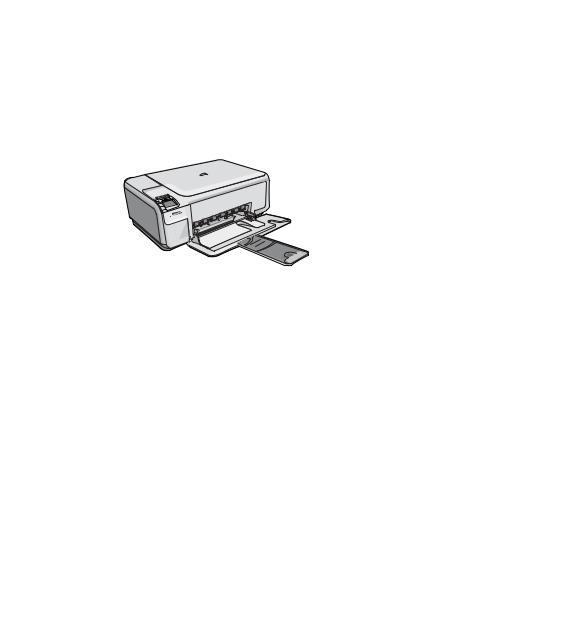
Chapter 2
Load paper
You can load different types and sizes of paper in the HP All-in-One, including letter or A4 paper, photo paper, transparencies, and envelopes. For more information, see the onscreen Help.
To load full-size paper
1. Slide the paper-width guide to its outermost position.
English
 NOTE: If you are using letter or A4 paper or smaller, make sure the tray extender is open all the way. When you use legal-size paper, leave the tray extender closed.
NOTE: If you are using letter or A4 paper or smaller, make sure the tray extender is open all the way. When you use legal-size paper, leave the tray extender closed.
2.Insert the stack of paper into the input tray with the short edge forward and the print side down. Slide the stack of paper forward until it stops.
CAUTION: Make sure that the product is idle and silent when you load paper into the input tray. If the product is servicing the print cartridges or otherwise engaged in a task, the paper stop inside the product might not be in place. You could push the paper too far forward, causing the product to eject blank pages.
3.Slide the paper-width guide inward until it stops at the edge of the paper.
Do not overload the input tray; make sure the stack of paper fits within the input tray and is no higher than the top of the paper-width guide.
14 HP Photosmart C4500 All-in-One series
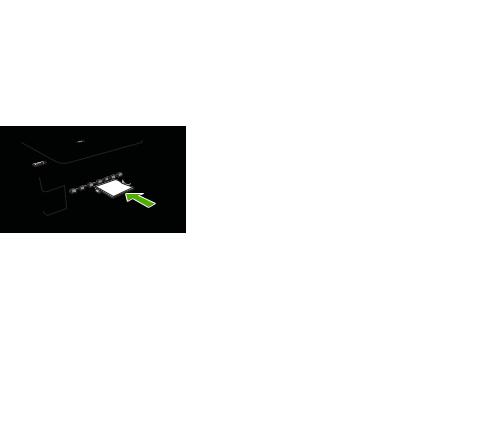
To load small-size photo paper in the input tray
1.Slide the paper-width guide to its outermost position.
2.Insert the stack of photo paper into the far-right side of the input tray with the short edge forward and the print side down. Slide the stack of photo paper forward until it stops.
If the photo paper you are using has perforated tabs, load the photo paper so that the tabs are closest to you.
English
3.Slide the paper-width guide inward until it stops at the edge of the paper.
Do not overload the input tray; make sure the stack of paper fits within the input tray and is no higher than the top of the paper-width guide.
Avoid paper jams
To help avoid paper jams, follow these guidelines.
•Remove printed papers from the output tray frequently.
•Prevent curled or wrinkled photo paper by storing all unused photo paper flat in a resealable bag.
•Ensure that paper loaded in the input tray lays flat and the edges are not bent or torn.
•If you are printing labels, ensure that the label sheets are no more than two years old. Labels on older sheets might peel off when the paper is pulled through the product, and cause paper jams.
•Do not combine different paper types and paper sizes in the input tray; the entire stack of paper in the input tray must be the same size and type.
•Adjust the paper-width guide in the input tray to fit snugly against all paper. Make sure the paper-width guide does not bend the paper in the input tray.
•Do not force paper too far forward in the input tray.
•Use paper types that are recommended for the product.
Avoid paper jams |
15 |
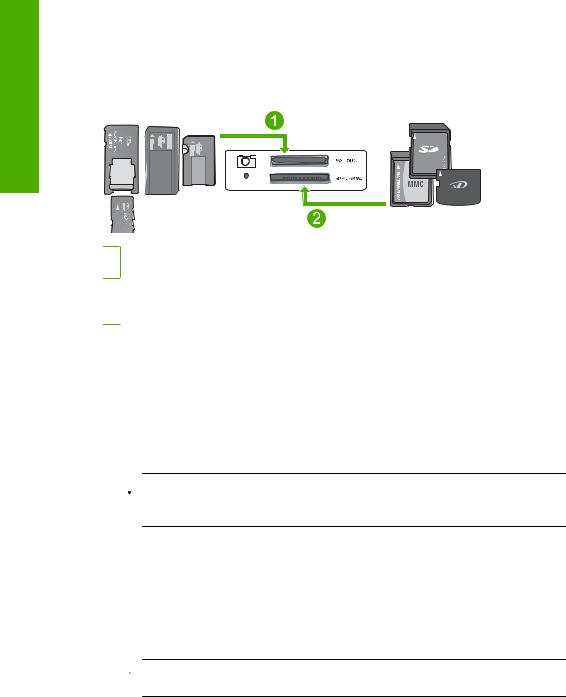
Chapter 2
Print a photo on photo paper
To achieve the best print quality, HP recommends using HP papers that are specifically designed for the type of project you are printing along with genuine HP ink. HP papers and HP ink are specifically designed to work well together to provide high-quality output.
English
1Memory Stick, Memory Stick Pro, Memory Stick Select, Memory Stick Magic Gate, Memory Stick Duo or Duo Pro (adapter optional), or Memory Stick Micro (adapter required)
2xD-Picture Card, Secure Digital (SD), Secure Digital Mini (SD Mini), Secure Digital High Capacity (SDHC), MultiMedia Card (MMC), MMC Plus, MMC Mobile (RS-MMC; adapter required), TransFlash MicroSD Card (adapter required), or Secure MultiMedia Card
To print photos
1.Load 10 x 15 cm (4 x 6 inch) photo paper in the input tray.
2.Insert your memory card into the appropriate slot on the product.
3.Press the buttons next to the up arrow or down arrow icons on the display to scroll through the photos on your memory card until the photo you want to print appears.
4.(Optional) Press Settings to change the print size, borderless settings, or number of copies. When you are done, press OK.
5.Press the button next to Print on the display.
 TIP: While the photo is printing, you can continue scrolling through the photos on your memory card. When you see a photo you want to print, you can press the Print button to add that photo to the print queue.
TIP: While the photo is printing, you can continue scrolling through the photos on your memory card. When you see a photo you want to print, you can press the Print button to add that photo to the print queue.
Scan an image
You can start a scan from your computer or from the control panel of the HP All-in-One. This section explains how to scan from the control panel of the HP All-in-One only.
To scan to a computer
1. Load your original print side down on the right front corner of the glass.
 NOTE: Ensure that there are no memory cards inserted in the memory card slots on the product.
NOTE: Ensure that there are no memory cards inserted in the memory card slots on the product.
2. Press the button next to Scan/Reprint.
16 HP Photosmart C4500 All-in-One series

3.Press the button next to Scan to PC.
 NOTE: If the product is network-connected, a list of available computers appears. Select the computer to which you want to transfer the scan, and then continue to the next step.
NOTE: If the product is network-connected, a list of available computers appears. Select the computer to which you want to transfer the scan, and then continue to the next step.
4.Follow the onscreen prompts to save the scan to your computer.
Replace the print cartridges
Follow these instructions to replace print cartridges. Following these instructions might also help solve print quality issues related to the cartridges.
 NOTE: When the ink level for the print cartridge is low, a message appears on your computer screen. You can also check the ink levels by using the software installed with the HP All-in-One.
NOTE: When the ink level for the print cartridge is low, a message appears on your computer screen. You can also check the ink levels by using the software installed with the HP All-in-One.
When you receive a low-ink warning message, make sure you have a replacement print cartridge available. You should also replace the print cartridges when you see faded text or if you experience print quality issues related to the print cartridges.
To order print cartridges for the HP All-in-One, go to www.hp.com/buy/supplies. If prompted, choose your country/region, follow the prompts to select your product, and then click one of the shopping links on the page.
To replace the print cartridges
1.Make sure the product is turned on.
 CAUTION: If the product is turned off when you open the print cartridge door to access the print cartridges, it will not release the cartridges for changing. You might damage the product if the print cartridges are not docked safely when you try to remove them.
CAUTION: If the product is turned off when you open the print cartridge door to access the print cartridges, it will not release the cartridges for changing. You might damage the product if the print cartridges are not docked safely when you try to remove them.
2.Make sure you have letter or A4 unused plain white paper loaded in the input tray.
3.Open the print cartridge door.
The print carriage moves to the far right side of the product.
4.Wait until the print carriage is idle and silent. Lightly press down on a print cartridge to release it, and then pull the print cartridge toward you out of its slot.
If you are replacing the tri-color print cartridge, remove the print cartridge from the slot on the left.
If you are replacing the black or photo print cartridge, remove the print cartridge from the slot on the right.
English
Replace the print cartridges |
17 |
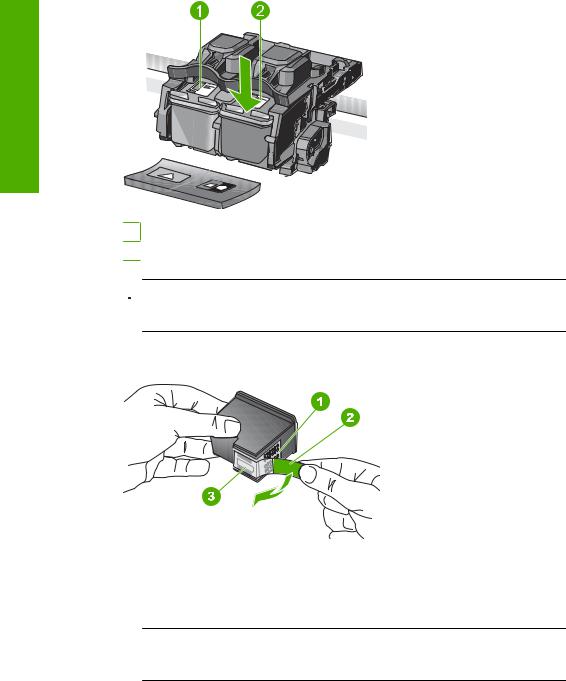
Chapter 2
English
1Print cartridge slot for the tri-color print cartridge
2Print cartridge slot for the black and photo print cartridges
 TIP: If you are removing the black print cartridge in order to install the photo print cartridge, store the black print cartridge in the print cartridge protector or an airtight plastic container.
TIP: If you are removing the black print cartridge in order to install the photo print cartridge, store the black print cartridge in the print cartridge protector or an airtight plastic container.
5.Remove the new print cartridge from its packaging and, being careful to touch only the black plastic, gently remove the plastic tape by using the pink pull tab.
1 |
Copper-colored contacts |
|
|
2 |
Plastic tape with pink pull tab (must be removed before installing) |
|
|
3 |
Ink nozzles under tape |
|
|
 CAUTION: Do not touch the copper-colored contacts or ink nozzles. Also, do not re-tape the print cartridges. Doing so can result in clogs, ink failure, and bad electrical connections.
CAUTION: Do not touch the copper-colored contacts or ink nozzles. Also, do not re-tape the print cartridges. Doing so can result in clogs, ink failure, and bad electrical connections.
18 HP Photosmart C4500 All-in-One series
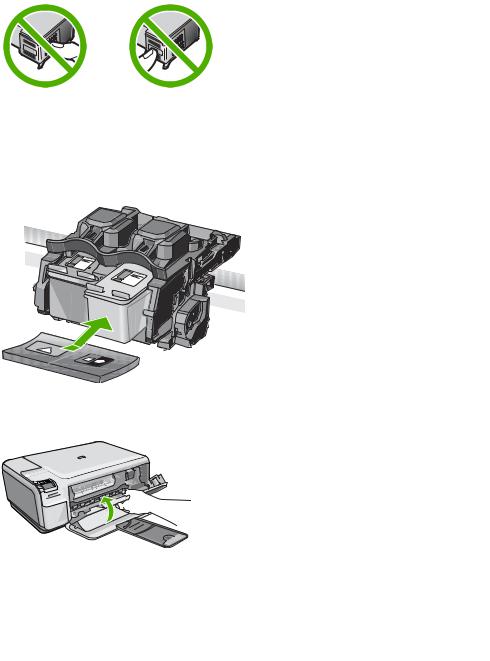
6. Hold the print cartridge with the HP logo on top, and insert the new print cartridge into the empty cartridge slot. Make sure you push the print cartridge in firmly until it snaps
into place. |
English |
|
If you are installing the tri-color print cartridge, slide it into the left slot. |
||
|
||
If you are installing a black or photo print cartridge, slide it into the right slot. |
|
7. Close the print cartridge door.
8.When prompted, press OK.
The product prints a print cartridge alignment page.
 NOTE: If you have colored paper loaded in the input tray when you align the print cartridges, the alignment will fail. Load unused plain white paper into the input tray, and then try the alignment again.
NOTE: If you have colored paper loaded in the input tray when you align the print cartridges, the alignment will fail. Load unused plain white paper into the input tray, and then try the alignment again.
9.Load the page print side down on the right front corner of the glass, and then press OK to scan the page.
10.When the On button stops flashing, the alignment is complete. Remove the alignment page and recycle or discard it.
Replace the print cartridges |
19 |

English
3 Troubleshooting and support
This chapter contains troubleshooting information for the HP All-in-One. Specific information is provided for installation and configuration issues, and some operational topics. For more troubleshooting information, see the onscreen Help that came with your software.
Many issues are caused when the HP All-in-One is connected to the computer using a USB cable before the HP All-in-One software is installed on the computer. If you connected the HP All-in-One to your computer before the software installation screen prompts you to do so, you must follow these steps:
Troubleshooting common setup issues
1.Disconnect the USB cable from the computer.
2.Uninstall the software (if you have already installed it).
3.Restart your computer.
4.Turn off the product, wait one minute, then restart it.
5.Reinstall the product software.
CAUTION: Do not connect the USB cable to the computer until prompted by the software installation screen.
For support contact information, see the inside back cover of this guide.
Uninstall and reinstall the software
If your installation is incomplete, or if you connected the USB cable to the computer before prompted by the software installation screen, you might need to uninstall and then reinstall the software. Do not simply delete the HP All-in-One application files from your computer. Make sure to remove them properly using the uninstall utility provided when you installed the software that came with the
HP All-in-One.
To uninstall and reinstall the software
1.On the Windows taskbar, click Start, Settings, Control Panel (or just Control Panel).
2.Double-click Add/Remove Programs (or click Uninstall a program).
3.Select HP Photosmart All-in-One Driver Software, and then click Change/Remove. Follow the onscreen instructions.
4.Disconnect the product from your computer.
5.Restart your computer.
 NOTE: It is important that you disconnect the product before restarting your computer. Do not connect the product to your computer until after you have reinstalled the software.
NOTE: It is important that you disconnect the product before restarting your computer. Do not connect the product to your computer until after you have reinstalled the software.
6.Insert the product CD-ROM into your computer’s CD-ROM drive and then start the Setup program.
 NOTE: If the Setup program does not appear, locate the setup.exe file on the CD-ROM drive and double-click it.
NOTE: If the Setup program does not appear, locate the setup.exe file on the CD-ROM drive and double-click it.
NOTE: If you no longer have the installation CD, you can download the software from www.hp.com/support.
7.Follow the onscreen instructions and the instructions provided in the Start Here guide that came with the product.
When the software installation is complete, the HP Digital Imaging Monitor icon appears in the Windows system tray.
20 HP Photosmart C4500 All-in-One series

To verify that the software is properly installed, double-click the HP Solution Center icon on the desktop. If the HP Solution Center shows the essential icons (Scan Picture and Scan Document), the software has been properly installed.
Setup troubleshooting
Use this section to solve any problems you might encounter while setting up the HP All-in-One hardware.
The product will not turn on
Try the following solutions if there are no light indications, no noise, and no movement from the product when you turn it on.
Solution 1: Make sure you use the power cord that came with the product
Solution
•Make sure the power cord is firmly connected to both the product and the power adapter. Plug the power cord into a power outlet, surge protector, or power strip.
•If you are using a power strip, make sure the power strip is turned on. Or, try plugging the product directly into a power outlet.
•Test the power outlet to make sure it is working. Plug in an appliance that you know works, and see if the appliance has power. If not, then there might be a problem with the power outlet.
•If you plugged the product into a switched outlet, make sure the outlet is switched on. If it is switched to on but still does not work, then there might be a problem with the power outlet.
Cause: The product was not being used with the power cord provided.
If this did not solve the issue, try the next solution.
Solution 2: Reset the product
Solution: Turn off the product, and then unplug the power cord. Plug the power cord back in, and then press the On button to turn on the product.
Cause: The product experienced an error.
If this did not solve the issue, try the next solution.
Solution 3: Press the On button more slowly
Solution: The product might not respond if you press the On button too quickly. Press the On button once. It might take a few minutes for the product to turn on. If you press the On button again during this time, you might turn the product off.
Cause: You pressed the On button too quickly. If this did not solve the issue, try the next solution.
Solution 4: Contact HP to replace the power supply
Solution: Contact HP support to request a power supply for the product. Go to: www.hp.com/support.
If prompted, choose your country/region, and then click Contact HP for information on calling for technical support.
Cause: The power supply was not intended for use with this product or it had a mechanical failure.
If this did not solve the issue, try the next solution.
Solution 5: Contact HP support for service
Solution: If you have completed all of the steps provided in the previous solutions and are still having a problem, contact HP support for service.
English
Setup troubleshooting |
21 |

English
Chapter 3
Go to: www.hp.com/support.
If prompted, choose your country/region, and then click Contact HP for technical support. Cause: You might need assistance to enable the product or software to function properly.
I connected the USB cable, but I am having problems using the product with my computer
Solution: You must first install the software that came with the product before connecting the USB cable. During installation, do not plug in the USB cable until prompted by the onscreen instructions.
Once you have installed the software, plug one end of the USB cable into the back of your computer and the other into the back of the product. You can connect to any USB port on the back of your computer.
For more information on installing the software and connecting the USB cable, see the Start Here guide that came with the product.
Cause: The USB cable was connected before the software was installed. Connecting the USB cable before you are prompted can cause errors.
After setting up the product, it does not print
Try the following solutions to resolve the issue. Solutions are listed in order, with the most likely solution first. If the first solution does not solve the problem, continue trying the remaining solutions until the issue is resolved.
Solution 1: Press the On button to turn on the product
Solution: Look at the display on the product. If the display is blank and the On button is not lit, the product is turned off. Make sure the power cord is firmly connected to the product and plugged into a power outlet. Press the On button to turn on the product.
Cause: The product might not have been turned on. If this did not solve the issue, try the next solution.
Solution 2: Set your product as the default printer
Solution: Use the system tools on your computer to change your product to be the default printer.
Cause: You sent the print job to the default printer, but this product was not the default printer. If this did not solve the issue, try the next solution.
Solution 3: Check the connection between the product and computer
Solution: Check the connection between the product and computer. Cause: The product and computer were not communicating with each other. If this did not solve the issue, try the next solution.
Solution 4: Check that the print cartridges are installed properly and have ink
Solution: Check that the print cartridges are installed properly and have ink. Cause: There might have been a problem with one or more of the print cartridges. If this did not solve the issue, try the next solution.
Solution 5: Load paper in the input tray
Solution: Load paper in the input tray.
Cause: The product might have been out of paper.
22 HP Photosmart C4500 All-in-One series

Network troubleshooting
If you are encountering issues using your HP All-in-One over a network, try the following steps in |
|
|
the order listed: |
|
|
1. Turn off the router, product, and computer, and then turn them back on in this order: router first, |
|
|
then the product, and finally the computer. Sometimes, cycling the power will recover a network |
|
|
communication issue. |
|
|
2. For wireless networking issues, run the Wireless Network Test from the product control panel. |
|
|
a. |
Press the Wireless button on the product. |
|
b. |
Press the button next to the down arrow on the display until Wireless Settings is |
English |
c. |
highlighted, and then press OK. |
|
is highlighted, and then press OK. |
||
Press the button next to the down arrow on the display until Run Wireless Network Test |
|
|
This prints the Wireless Network Test page.
If a problem is detected, the printed test report will include recommendations that might help solve the problem. If you need to configure the network settings on the HP Photosmart C4500 All-in-One series, follow the instructions given below:
Double-click the HP Solution Center icon, click Settings, click Other Settings, select Network Toolbox, and then select the Network Setup Wizard link.
3. If the previous steps do not solve the problem and you have successfully installed the HP Photosmart Software on your computer, run the Network Diagnostic tool.
 NOTE: The diagnostic test might prompt you to connect a USB cable between the product and your computer. Position the product and computer near each other and have a USB cable readily accessible.
NOTE: The diagnostic test might prompt you to connect a USB cable between the product and your computer. Position the product and computer near each other and have a USB cable readily accessible.
To run the Network Diagnostic tool
▲In the Solution Center, click Settings, click Other Settings, and then click Network Toolbox. On the Utilities tab, click Run Network Diagnostics.
If you are unable to run the Network Diagnostic tool or it does not help solve the problem, check the following sections for additional information:
1.Make sure that the computer is connected to your network
2.Make sure that the product is connected to your network
3.Check to see if the firewall software is blocking communication
4.Make sure the product is online and ready
5.Make sure the HP Device Discovery software is running
Step 1: Make sure that the computer is connected to your network
To check a wired (Ethernet) connection
▲Where the Ethernet cable from the router connects to your computer, check to see if the indicator lights are on. Usually there are two indicator lights, one that is on and another that blinks.
If you do not see any lights, try reconnecting the Ethernet cable to the computer and the router. If you still do not see lights, there might be a problem with the router or your computer.
Network troubleshooting |
23 |

English
Chapter 3
To check a wireless connection
1.Make sure that the wireless radio on your computer is turned on.
2.If you are not using a unique network name (SSID), then it is possible that your wireless computer could be connected to a nearby network that is not yours. The following steps can help you determine if your computer is connected to your network.
a. Depending on your operating system:
•Windows XP: Click Start, point to Control Panel, point to Network Connections, and then select View/Details.
OR
Windows XP: Click Start, point to Settings, point to Control Panel, point to Network Connections, and then select View/Details.
•Windows Vista: Click Start, point to Control Panel, point to Network Connections, and then click View Network Status and Tasks.
Leave the network dialog box open while you continue to the next step.
b. Disconnect the power cord from the wireless router. The connection status of your computer should change to Not Connected.
c. Reconnect the power cord to the wireless router. The connection status should change to
Connected.
If you are unable to get your computer connected to your network, contact the person who set up your network or the router manufacturer as there might be a hardware issue with either your router or computer.
If you are able to access the Internet, you can also access the HP Network Assistant at http:// www.hp.com/sbso/wireless/tools-setup.html?jumpid=reg_R1002_USEN for help in setting up a network.
Step 2: Make sure that the HP All-in-One is connected to your network
If your product is not connected to the same network as your computer, you will not be able to use the product over the network. Follow the steps described in this section to find out if your product is actively connected to the correct network.
A: Make sure the product is on the network
▲Print the product Network Configuration Page, then check the Network Status and URL.
To print the Network Configuration Page a. Press the Wireless button on the product.
b. Press the button next to the down arrow on the display until Wireless Settings is highlighted, and then press OK.
c. Press the button next to the down arrow on the display until Print Network Configuration Page is highlighted, and then press OK.
This prints the Network Configuration Page.
Network Status |
• If the Network Status is Ready, the product is actively connected to |
|
a network. |
|
• If the Network Status is Offline, the product is not connected to a |
|
network. Run the Wireless Network Test (using the instructions at |
|
the beginning of the Network Troubleshooting section) and follow |
|
any recommendations. |
|
|
URL |
The URL shown here is the network address assigned to the product by |
|
your router. You will need this address for step 2. |
|
|
B: Check to see if you can access the HP Photosmart C4500 All-in-One series home page
After you establish that the computer and the HP All-in-One both have active connections to a network, you can verify if they are on the same network by accessing the HP Photosmart
24 HP Photosmart C4500 All-in-One series

C4500 All-in-One series home page. (The home page is a Web page that resides within the HP All-in-One.)
To access the HP Photosmart C4500 All-in-One series home page
▲On your computer, open the Web browser you normally use to access the Internet (for example, Internet Explorer.) In the Address box, type the URL of the product as it was shown on the Network Configuration Page (for example, http://192.168.1.101.)
The HP Photosmart C4500 All-in-One series home page should appear.
 NOTE: If you are using a proxy server in your browser, you might need to disable it to access the Embedded Web Server.
NOTE: If you are using a proxy server in your browser, you might need to disable it to access the Embedded Web Server.
If you can access the HP Photosmart C4500 All-in-One series home page, try using the product over the network (such as to scan or print) to see if your network setup was successful.
If you cannot access the HP Photosmart C4500 All-in-One series home page or are still having problems using the product over the network, continue to the next section regarding firewalls.
Step 3: Check to see if the firewall software is blocking communication
If you cannot access the HP Photosmart C4500 All-in-One series home page and are sure both the computer and HP Photosmart C4500 All-in-One series have active connections to the same network, the firewall security software might be blocking communication. Turn off any firewall security software running on your computer and then try to access the HP Photosmart C4500 All-in-One series home page again. If you can access the home page, try using the HP Photosmart C4500 All-in-One series (for printing or scanning).
If you are able to access the home page and use your HP Photosmart C4500 All-in-One series with the firewall turned off, you will need to reconfigure your firewall settings to allow the computer and HP Photosmart C4500 All-in-One series to communicate with each other over the network. For more information, see “Configure your firewall to work with HP products” on page 8.
If you are able to access the HP Photosmart C4500 All-in-One series home page but are still unable to use the HP Photosmart C4500 All-in-One series even with the firewall turned off, continue to steps 4 and 5.
Step 4: Make sure the product is online and ready
To check the printer status
1.Do one of the following, depending on your operating system:
•Windows XP: Click Start, point to Printers and Faxes, and then select View/Details.
•Windows Vista: Click Start, point to Control Panel, and then select Printers and Faxes.
2.Do one of the following, depending on the printer status:
•If the product says Offline, right-click the product and select Use Printer Online.
•If the product says Paused, right-click the product and select Resume Printing.
3.Try using the product over the network.
If you can use the product after performing the steps above but find that the symptoms persist as you continue to use the product, your firewall might be interfering. For more information see “Configure your firewall to work with HP products” on page 8. If you still cannot use the product over the network, continue to the next section for additional troubleshooting help.
Step 5: Make sure the HP Network Devices Support service is running
To restart the HP Network Device Support service
1.Delete any print jobs currently in the print queue.
2.Do one of the following, depending on your operating system:
•Windows XP: Click Start, right-click My Computer, and click Manage. Double-click
Services and Applications, and then select Services.
•Windows Vista: Click Start, right-click Computer, and click Manage. Double-click
Services and Applications, and then select Services.
English
Network troubleshooting |
25 |

English
Chapter 3
3.Scroll down the list of services, right click HP Network Devices Support, and then select
Restart.
4.After the service restarts, try using the product over the network again.
If you are able to use the product over the network, your network setup was successful.
If you still cannot use the product over the network or if you have to periodically perform this step in order to use your product over the network, your firewall might be interfering. For more information see “Configure your firewall to work with HP products” on page 8.
If this still does not work, there might be a problem with your network configuration or router. Contact the person who set up your network or the router manufacturer for help.
Clear paper jams
In case of a paper jam, check the rear door. You might need to clear the paper jam from the rear door.
To clear a paper jam from the rear door
1.Press in the tab on the left side of the rear door to release the door. Remove the door by pulling it away from the product.
2.Gently pull the paper out of the rollers.
 CAUTION: If the paper tears when you are removing it from the rollers, check the rollers and wheels for torn pieces of paper that might be remaining inside the product. If you do not remove all the pieces of paper from the product, more paper jams are likely to occur.
CAUTION: If the paper tears when you are removing it from the rollers, check the rollers and wheels for torn pieces of paper that might be remaining inside the product. If you do not remove all the pieces of paper from the product, more paper jams are likely to occur.
3.Replace the rear door. Gently push the door forward until it snaps into place.
4.Press OK on the control panel to continue the current job.
Print cartridge troubleshooting
If you are experiencing problems with printing, you might have a problem with one of the print cartridges. For more information, see “Replace the print cartridges” on page 17 in this guide.
Support process
If you have a problem, follow these steps:
1.Check the documentation that came with the product.
2.Visit the HP online support Web site at www.hp.com/support. HP online support is available to all HP customers. It is the fastest source for up-to-date product information and expert assistance and includes the following features:
•Fast access to qualified online support specialists
•Software and driver updates for the product
•Valuable product and troubleshooting information for common problems
•Proactive product updates, support alerts, and HP newsgrams that are available when you register the product
3.Call HP support. Support options and availability vary by product, country/region, and language. For support contact information, see the inside back cover of this guide.
26 HP Photosmart C4500 All-in-One series
